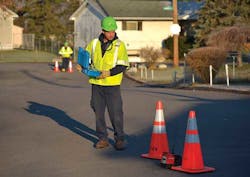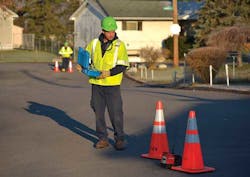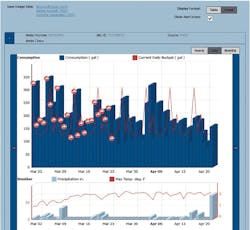Examining the Importance of Managing Data and Keeping Customers Informed
By Art Haddaway, WaterWorld Editor
Throughout their day-to-day operations, water and wastewater utilities must disseminate a large amount of data and information to their customers. This can include material pertaining to plant processes, systems and equipment in the field, public programs and events, and critical projects or repairs occurring in the community, among others.
While it's important that these plants manage this data effectively, it's even more crucial that they circulate it in a way that's timely, relevant and easily accessible for their customers and that these individuals are able to understand and ultimately relate to what is being conveyed.
Undeniably, a large component of a facility's activities is dedicated to customer engagement services. In fact, many water districts and utilities across the nation oversee a wide range of customer-related tools and technologies and are tasked with maintaining their applicability. This effort can involve the use of data analytics, advanced meter reading (AMR) and advanced metering infrastructure (AMI), customer information systems, online billing and account management, and leak detection, to name a few.
According to Black and Veatch, these portals are essential to improving how utilities network with their customers. "Customers are influenced by a variety of factors -- reliability of their service, the responsiveness of the call center, and the price and accuracy of their bills," the company's website stated. "Customer engagement services are designed to improve customer satisfaction by enhancing customer interactions, improving billing and collections, and increasing customer interaction in conservation activities."
These systems enable plants to better communicate with their customers about their water usage, along with important news and events, as well as help these individuals stay well-informed, educated and involved in local water processes. This effort also contributes to establishing a solid relationship with ratepayers and provides opportunities for further development in the community. Ultimately, connecting and engaging with customers is key to a successful industry as a whole.
"Water is such a precious resource," said Karla Teasley, vice president of Customer Service for American Water. "We want our customers to understand that value and help them manage the resource as effectively as possible." She explained that building on the capabilities of AMR and expanding on AMI, for example, places "that information in the hands of customers so they can manage their water use, be aware of leaks immediately, and [get] those addressed before there's any real water loss or cost to them," she said.
As technology has advanced over the years, the methods by which utilities connect with and relay data to customers have also evolved. Facilities are now utilizing social media, upgrading websites, creating online blogs and video channels, offering interactive mobile services, hosting outreach and education forums, and more -- especially since most people have embraced these outlets as their primary sources of interaction and information.
In fact, a recent report by the Water Research Foundation and Environmental Protection Agency indicated that customer contact and engagement systems are in demand and are progressively being incorporated across the market. "There are few aspects of water utility operations where the potential for improving the use of technology is greater than in customer service," it stated. "As technology evolves rapidly, there is increasing pressure to adopt and incorporate new technologies into customer contact center applications and processes."
When it comes to introducing these systems, utilities need to consider the fact that much of the decision comes down to meeting rising customer expectations, said Teasley. "Those expectations are changing, and [customers] expect information at the touch of a button; they expect to know what things cost and what they're using and how to interact with … providers to really optimize their experience.
"The future, in my mind, is figuring out and asking our customers how they want communication [coming] to them. What is their preference? What type of communication vehicles [do they need]?" she continued. "We blanket customers with a lot of different kinds of communication approaches to be able to ensure that those messages are received."
Dan Byrnes, group vice president of product development and solution consulting for Oracle Utilities, added that water facilities should make customer choice a priority and recognize their preferred means of interaction. "We provide the utility with a broad set of technologies all integrated back into the customer experience," he said. "Oracle's objective is to take all of those channels … and make all that technology available, and we encourage the utility to then let the customer pick which type of communication channel they want for which type of event."
When it comes to incorporating these tools and technologies in the field and relating to customers, companies such as American Water, Oracle and many others are making great strides in this area. For example, Teasley noted that American Water has expanded its web self-service capabilities, including a unique and interactive program called My H2O Online, where customers can easily pay bills, verify their amount, check usage over time, make appointments, and more. The organization is also growing its paperless billing program, striving for a more convenient and environmentally friendly option.
American Water is also concentrating its efforts into an AMI pilot project in California, where around 200 customers can access and observe their water usage data on a real-time basis through a web portal and set up alerts to be notified immediately if there's an issue or if they exceed a specific amount of usage. Likewise, the organization has established "CodeRED," an emergency communicator system that allows staff to call customers in any emergency or inform them of planned work. This also occurs through an online map-based interface, where individuals can confirm if they're impacted by a particular event.
"There are many different ways that we interact with customers from a communication perspective," said Teasley. "We focus on making that interaction a caring relationship because that's what customers expect -- they want to know that they have a relationship with the utility that really focuses on them and that we care about them and we care about the safety of our water and the reliability of their water, and that is paramount."
Accordingly, Oracle offers Oracle Utilities Customer Care and Billing, a customer information system (CIS) that serves as a customer suite of applications and functionality, explained Byrnes. The program is integrated into many of the company's social monitoring and interaction management technologies and also extends into multi-channel web platforms such as desktops and mobile devices and customer contact centers. It also works as a rating engine designed to curve consumption and adjust rates accordingly, especially during periods of intense drought.
Oracle has also integrated an analytics platform designed to alert customers of high bills or consumption throughout the month, allowing them to adopt budget billing through self-enforcement monitoring, according to Byrnes. This is based on data from meters centered on residential sprinkling programs. "Using all those analytics, you can drive those programs and push that information out to the CIS call center so the customer has all the information when they call in, and you can automatically push it out to the web …and those campaigns and events onto mobile devices as well," he said.
Another entity leading the way in this area is Neptune Technology Group. The company has developed a product called Insight IQ, which ultimately serves as a massive warehouse that stores large amounts of meter data (billions of records) for up to 10 years, according to John Sala, director of marketing for systems at Neptune. It also provides direct utility-customer engagement pulls -- "a web portal for a utility's customers to see and have access to that highly detailed data that often times is coming from these big advanced metering infrastructure systems," he said.
Neptune has also established a Connected Utility Partnership Program that serves as a state-of-the-art platform for the company and other industry-leading vendors to come together and collaborate on shared data across a variety of applications. Moreover, it was created to "meet the growing needs of water utilities by extending Neptune's capabilities beyond meter reading," noted a press release. "The goals of the program are to communicate field data across departments and to leverage the institutional knowledge within the utility personnel to create a Smart Water Utility."
Reinforcing these customer engagement services not only benefits the public in numerous ways but also helps utilities reduce costs, conserve energy, enhance productivity, optimize workforce management, and more. It ultimately puts "customers directly in control and aware of their water usage and any issues such as a leak so they can totally self-serve, reducing utility's overhead while also substantially improving their experience," said Sala. "Those are all things that can't happen unless you have systems that can communicate and interoperate."









